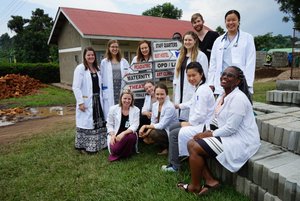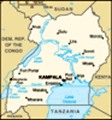Advertisement
Published: June 16th 2019

 The squad
The squad
Sparkling white coats and eyes full of medicine... What else could we ask for?To my dear friends and family,
I know, I know, I've been terrible at keeping you all up to date with my Ugandan adventure. These past couple weeks have been busier than expected and my blog has been placed on the backburner. But I am back and ready to brag about the amazing time we’ve been having in the Pearl of Africa!
At the time of my last blog, I had just arrived in Rugazi for a week of clinical learning and community touring. Five people joined our team for the occasion: two medical students from the U of S, Brianna and Jennifer, and their supervisor Dr. Amber, as well as two Ugandan students from MUST, Ken and Resti. Our days consisted of mornings in the wards of Rugazi's Health Center IV (abbreviated to HC IV), and afternoon excursions with the VHT Leader (Village Health Team Leader named Devina) to interview elders and experience the village. For those not familiar with the Ugandan healthcare system, here’s a quick summary: the smallest villages have an HC I manned by a volunteer VHT member which is equipped to deal with minor health issues. As communities get larger, they have larger and

 Future dietitians at work
Future dietitians at work
Angela, Victoria, and I finding the recipe for F100 therapeutic milk for the malnutrition patient.better equipped health centers II, III, IV, and finally university hospitals like the one in Mbarara in which we will be working in July. Rugazi has an HC IV divided into outpatient, maternity, pediatric, female medical, and male medical ward in addition to having an operating room, antenatal clinic, ART (antiretroviral therapy) clinic, and a medical laboratory. So as you can guess, there’s no shortage of interesting medical events from which we learn in Rugazi.
Being a first year nutrition student, I had never learned or worked in a clinical setting. I was excited, and I got to attend a C-section birth on my first morning. However, the constant standing during rounds and heat (we wear lab coats over our clothing which does not improve the already humid and hot environment) got to me and I had to sit down for fear of passing out. I was worried- was I too soft for the clinic? I have a (not so) secret dream of becoming a physician after my degree in Nutrition- would I need to kiss my plan good-bye because I can't handle the sight of blood? (Actually, blood is fine, it’s adipose tissue that got me.) The others

 Exhausted and sweaty, we made it!
Exhausted and sweaty, we made it!
The path was too narrow for more than one person and our differences in height clearly show the hill we scaled.reassured me with fainting stories of their own so I attributed this situation to my inexperience. The rest of the week went by with no problem, so maybe I toughened up?
Aside: best part of the C-section? Seeing the baby's head full of hair through the amniotic sac before the surgeon cut through it. A real little human was in there, and all the sudden, a child was being born into our world. It was awe-inspiring. What was also surprising was the young age of the mother. I knew that the average woman in Uganda has six children, but I didn’t understand how this fact translated into a clinical setting. While the other wards were at one-third of their capacity, maternity was almost always full of young labouring moms, many of them on their third or fourth birth despite only being 21 or 22 years old.
Morning rounds were the favourite part of my days. It was fascinating to watch Amber and Ken (who acted as our translator from English to Ruwan Acholi, the language of the region) unpack a diagnosis from a set of unspecific symptoms and simple physical exams. Patients often came into the clinic with
a single complaint but they ended up being treated for multiple conditions. Every second patient had some form of anemia and a fever was usually indicative of malaria. The Nutrition students also had their time to shine since a toddler came in with acute malnutrition. We were tasked with finding the recipe for a therapeutic refeeding solution and charting the child's weight on a growth chart. Despite having the classic physical signs of Marasmus, the child was not a severe case, and we expect him to recover without long-term repercussions.
On the afternoon of the first day, Devina took us to interview elders and residents of Rugazi about their healthcare concerns. Among those cited were HIV (the western region of Uganda happens to have the highest rates of HIV in the country), malaria, respiratory infections, and a lack of employment leading to gambling and alcohol addictions. To return to Rugazi, we circled around one of the many crater lakes in the region and we had to hike an incredibly steep hill-we must have been climbing at 60° in some spots. The amazing thing was that this hill was still cultivated with lush banana and coffee plantations all the way

 Crater Walk
Crater Walk
The crater walk is so beautiful! Even the twilight insect swarms couldn't ruin it.down. It was beautiful.
Another adventure involving a walk: I lost my room key right before the group was setting out for a walk around another crater lake so Brooke and I stayed behind until we found it. Following the vague instruction of “stay to the right,”, we set out to catch up to the group. It happened to be around 5pm, which is the end of the school day, and as we walked by a primary school, a horde of thirty kids started following us. It turns out that many of them lived several kilometers down that road, and they walked that distance every day for school. The kids thought everything the mzungus did was hilarious such as our attempts at speaking Ruwan Acholi which were met with ruckus laughter. On a less happy note, Brooke and I witnessed first hand how being white is automatically associated with money in the eyes of many here in Uganda. We had to curb several blatant “give me money” requests from the kids. Some would argue that we should give money to those who ask, but it becomes an issue of security when you open your purse while surrounded by thirty little people. Before leaving Canada, we were advised against giving anything since it would only attract more demands that we can’t fill and makes us vulnerable to theft. This leaves us in the uncomfortably selfish position of saying no.
On June 9th, we returned to Mbarara for our Leadership Community Program (LCP) aka the long-awaited orientation at MUST. I will save the events of last week for my next blog post since this one is already long enough.
Until next time!
Advertisement
Tot: 0.086s; Tpl: 0.015s; cc: 10; qc: 48; dbt: 0.0543s; 1; m:domysql w:travelblog (10.17.0.13); sld: 1;
; mem: 1.2mb







